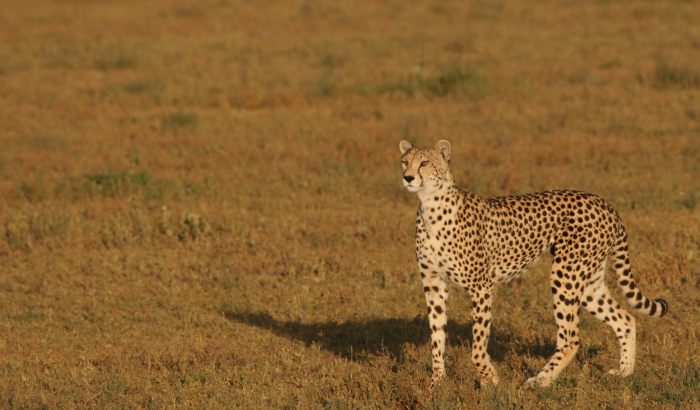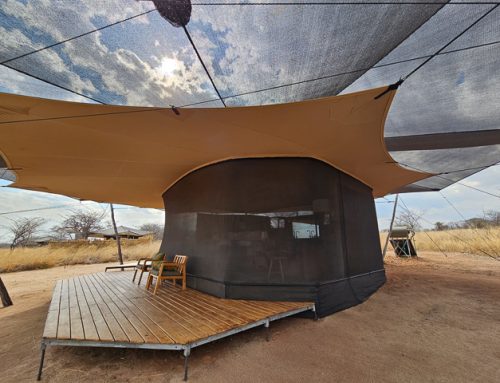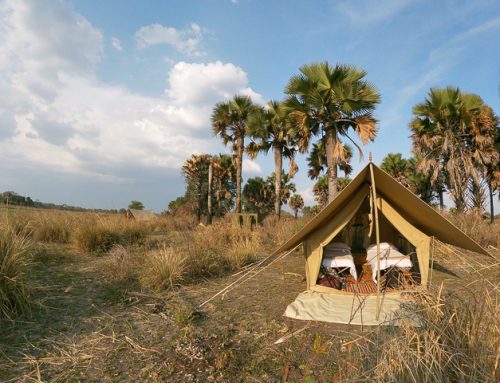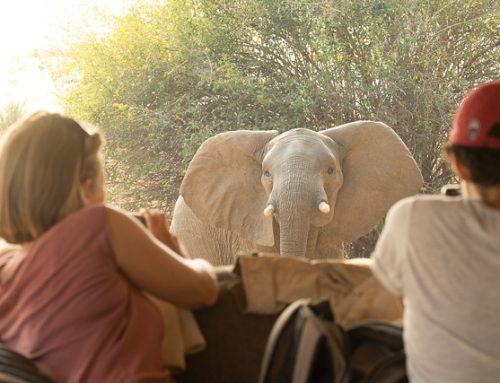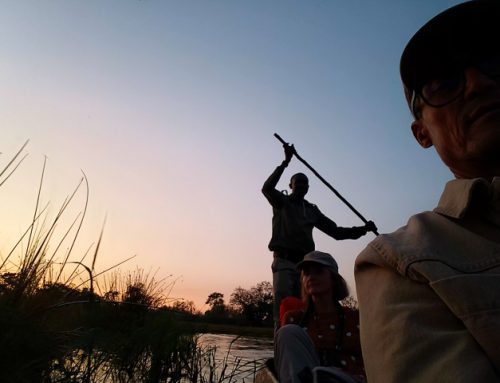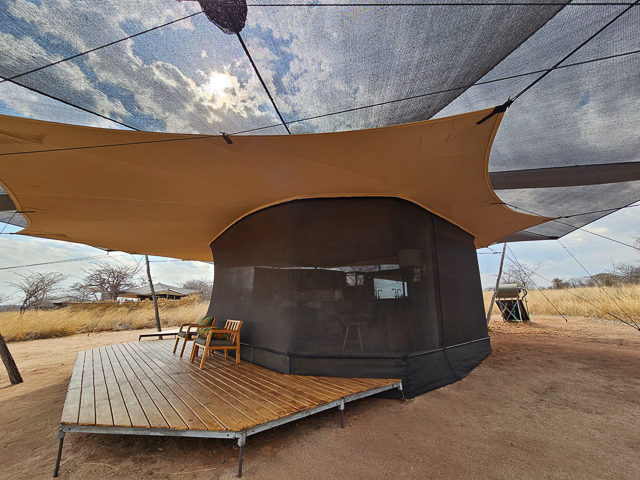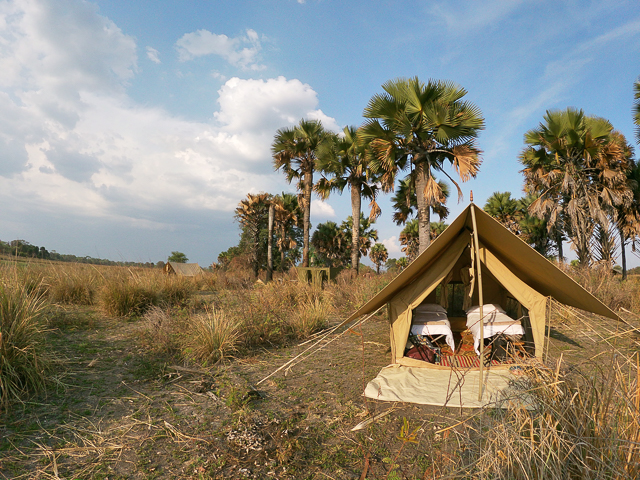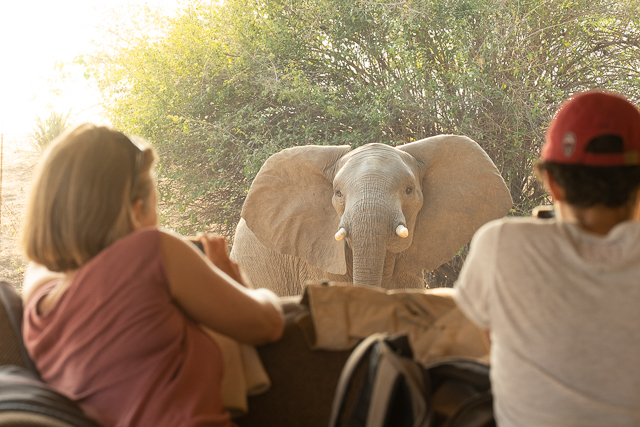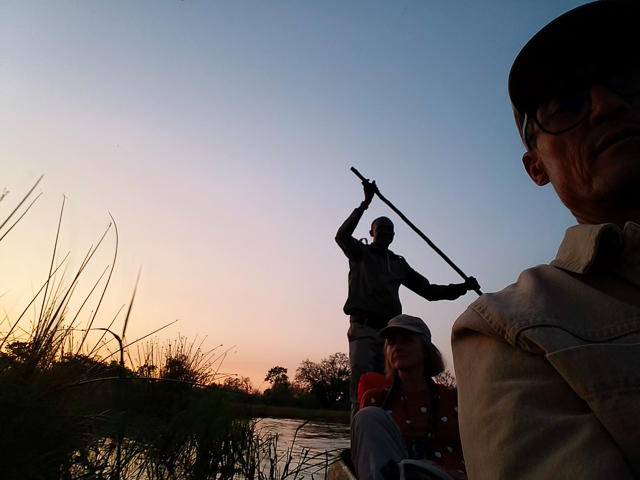Safari guides Dave, Ole Kirimbai and I have just come back from another wonderful safari in the Serengeti with some great folks from western Canada. Although it was the “green season” it hadn’t rained for a while so, while a lot of the game was out on the Plains or in the surrounding woodland, it was very dry. When I remember this safari I will always think of the cheetah (Acinonyx jubatus), the most endangered big cat in Africa (see the bottom of this article to learn about population levels).
I once guided a safari in the Serengeti and we never saw these wonderful animals. Only once! I couldn’t believe it, as the Serengeti is one of the best places in the world to see them. While we saw many lions, a serval and other exciting predators, we never saw a cheetah. Not one. I kept saying this was very unusual, and the Serengeti was a good place to see cheetahs, but even today the same folks wink and nod their heads, and suggest that it is a hoax and is just part of the marketing – “Serengeti – cats – cheetahs”. If they really want to get at me, they hint that perhaps they would see cheetahs if they had a different guide!
Cheetahs are really and truly stunning, sleek, slender, superb, sexy cats (I should send that line to the cheetah researchers)! I once had a film crew on safari filming the “Wild Things” series for Paramount. It was one of these modern CNN style documentaries of sound bite sized news clips of wildlife in action. It was actually very popular at the time. The guys wanted action – a kill.
Well I can guide safaris for a whole year and if I am lucky I might see one or two kills, so you can imagine how difficult a request like that is! Most wildlife photographers spend months in one area trying to get the right scene. However, the good thing about most film crews is they will do whatever is necessary to get their shot, including waiting in one spot for hours on end.
If you want to film a kill, you need to find a predator. While there are a lot of small predators (servals, jackals, ratels, mongooses etc) most people want to see the big guys in action as they kill big prey (lions, leopards, cheetahs, hyenas and wild dogs). Of these, three are mainly nocturnal (lions, leopards, hyenas), or at 
Well, when I received that request I realized I had to find a hungry cheetah, and so we set off for Gol kopjes, one of the most magical places on this planet. 
Suddenly she wasn’t there! We all dropped our novels and scanned around. Where is she? Then we saw her stalking a hundred yards ahead of us. The film guys said “Let’s roll”. I was meant to provide a commentary, and before I knew it the camera was on me, we were moving, the cheetah had begun her chase, and I had to say something sensible. I began by saying how we came across this cheetah who seemed hungry, and now she is hunting, and then continued a bit like a rugby commentator. We were charging across the Plains, the camera was bouncing up and down, and the cheetah had made her kill. We just got the end of the kill in the distance on camera, and were approaching to film her biting the gazelle’s throat and beginning to eat it when we saw a hyaena rushing towards her, and a minute later she had run off, and the hyaena was crunching into the “Tommie” as if it were a pretzel. This is how many cheetah kills end, and is why the really smart experienced cheetahs look out for other predators before attempting any chase. Despite our unpreparedness and the unexpected outcome, the shoot was a success and we headed back to camp in high spirits.
Well, I really chose to write about cheetahs, because this last safari we saw a phenomenal amount of them. In fact aside from the 2 we saw in Ngorongoro Crater, 
Our first Serengeti sighting was a female with three sub-adult cubs. They were a lot of fun to watch as they were hungry. We watched them look for prey, fan out and sweep an area in the hope of flushing a hare or young gazelle, stalk, and we saw a chase. At this age (about a year old) they are becoming more involved in hunts, but lack the experience and patience to pull them off successfully. They were stalking a
Our second camp was still in the Serengeti Plains, but was outside any conservation or protected area, in Piyaya (Loliondo). Here on our last day in
Just then we saw a lost baby wildebeest trotting from a rise towards them. Quickly the cheetahs crouched down low in a patch of long grass and waited. We couldn’t imagine they would hunt again, although this opportunity would be an excellent one for the mother to train her cubs to kill. The wildebeest continued in its aimless journey closer and closer to the cheetahs, until it was almost on top of them. Then they burst o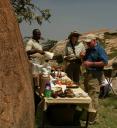
Justin
Note: All the photographs displayed in this article were taken by either Justin Bell or Dave Christensen while on this one safari.
INTERESTING FACTS AND INFORMATION ON THE CHEETAH
Weight – 30-65 kg
Length – 100-150 cm
Tail length – 50-90 cm
Shoulder height – 60-85 cm
The cheetah is the fastest animal on land reaching a maximum 
DID YOU KNOW?
1. Female cheetahs live alone or with dependent cubs, whereas males either live alone or in permanent coalitions of two or three individuals?
2. In the Serengeti National Park (Tanzania), the males compete over territories of about 40km2 on average. This is why sometimes it is an advantage for males to form coalitions of 2 or 3 individuals, as coalitions keep territories for longer. Many single males occupy smaller territories where few females roam, or become nomadic covering huge ranges, and must be constantly on watch for resident male cheetahs, as well as other predators. In Namibia the males occupy ranges of about 2,200 km2 !
3. Females utilize huge annual home ranges of about 800 km2 in the Serengeti,Tanzania, sometimes having favourite dry season and wet season areas that are far apart. In Namibia they have larger ranges of about 3,800 km2 !
4. Cheetah cubs in the Serengeti suffer extraordinarily high mortality. A study of radio-collared females showed that only 36% of cubs reach 2 months of age, and only 5% survive until independence at 18 months. 75% of known cub mortality is due to lion predation (So much for “The Lion King” portraying lions as “goodies”)!
ESTIMATED POPULATIONS OF CHEETAH
Worldwide – 9-12,000 (CITIES 1992)
African countries with highest populations:
Namibia 2,500
Botswana 1,800
Kenya – 900+ (800 estimated in protected areas)
Zimbabwe 600-1,000
Tanzania – 600-1,000 (40% sightings in protected areas)
South Africa – 500-700
Asiatic population (Iran) – 100
THE CHEETAHS WE SAW
In the Serengeti Plains (an area in the south-eastern corner of the Serengeti National Park covering approximately 2,200 sq km.) there are 50 adult females and 20 territorial males. If you are keen to learn more here is a report on the Serengeti Plains cheetahs by Sarah Durant, Marcella Kelly and Tim Caro on the Oxford Journals site.
If you have photographs of cheetahs in the Serengeti and know the location and date that you saw them visit the Tanzania Cheetah Conservation Programme site.
THE SERENGETI
The area of the whole Serengeti national park is about 15,000 sq km.
The Serengeti ecosystem comprises the Masai Mara Game Reserve in Kenya, and the Serengeti National Park, Maswa, Ikorongo and Grumeti Game Reserves, the Loliondo Game Controlled Area and Ngorongoro Conservation Area in Tanzania. The area of the ecosystem is about 30,000 sq km.

